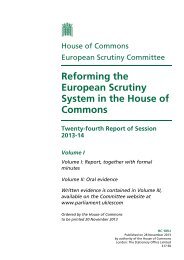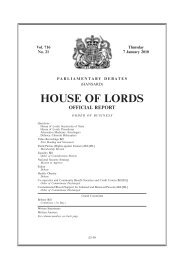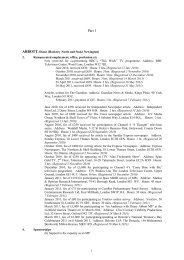Ticketing and Concessionary Travel on Public Transport - United ...
Ticketing and Concessionary Travel on Public Transport - United ...
Ticketing and Concessionary Travel on Public Transport - United ...
Create successful ePaper yourself
Turn your PDF publications into a flip-book with our unique Google optimized e-Paper software.
16<br />
Oyster <strong>on</strong> rail services in L<strong>on</strong>d<strong>on</strong><br />
Oyster is available <strong>on</strong> all L<strong>on</strong>d<strong>on</strong> Overground services <str<strong>on</strong>g>and</str<strong>on</strong>g> <strong>on</strong> interavailable routes <strong>on</strong><br />
other Nati<strong>on</strong>al Rail services. Oyster is available from around 100 stati<strong>on</strong>s served by<br />
Nati<strong>on</strong>al Rail.<br />
The rules governing what journeys can be made from these stati<strong>on</strong>s are complicated as not<br />
all services accept Oyster Pay-as-you-Go. This causes a large degree of customer c<strong>on</strong>fusi<strong>on</strong>.<br />
On the L<strong>on</strong>d<strong>on</strong> Overground, which TfL took over in November 2007, Oyster Pay-as-you-<br />
Go is accepted at all stati<strong>on</strong>s <str<strong>on</strong>g>and</str<strong>on</strong>g> <strong>on</strong> all routes. Additi<strong>on</strong>ally Chiltern <str<strong>on</strong>g>and</str<strong>on</strong>g> c2c accept Oyster<br />
<strong>on</strong> all their routes within L<strong>on</strong>d<strong>on</strong>; One Railway (now Nati<strong>on</strong>al Express East Anglia)accepts<br />
Oyster <strong>on</strong> all services in the Hackney area; <str<strong>on</strong>g>and</str<strong>on</strong>g> L<strong>on</strong>d<strong>on</strong> Midl<str<strong>on</strong>g>and</str<strong>on</strong>g> accepts Oyster between<br />
L<strong>on</strong>d<strong>on</strong> Eust<strong>on</strong> <str<strong>on</strong>g>and</str<strong>on</strong>g> Watford Juncti<strong>on</strong>.<br />
The roll out of Oyster to the remaining L<strong>on</strong>d<strong>on</strong> stati<strong>on</strong>s depends <strong>on</strong> when the Train<br />
Operating Companies <str<strong>on</strong>g>and</str<strong>on</strong>g> TfL c<strong>on</strong>clude the commercial agreements. TfL expects this to be<br />
in 2009.<br />
Smartcards in L<strong>on</strong>d<strong>on</strong>—Oyster <str<strong>on</strong>g>and</str<strong>on</strong>g> ITSO<br />
46. A major dilemma is that the biggest smartcard system in the UK is not an ITSO system,<br />
but the L<strong>on</strong>d<strong>on</strong> Oyster. Despite its success, Oyster cannot be developed into a nati<strong>on</strong>al<br />
system. Oyster was developed before ITSO <str<strong>on</strong>g>and</str<strong>on</strong>g> they are currently incompatible.<br />
47. An interoperability study is underway, funded by the Government, to assess the<br />
feasibility of adding ITSO readers to the Oyster system. It was suggested to us by TranSys<br />
that it would be possible to produce a single card c<strong>on</strong>taining both types of chip, but the<br />
arrangements required to support both systems would be complex. There are also potential<br />
problems with the l<strong>on</strong>ger time it takes to read <str<strong>on</strong>g>and</str<strong>on</strong>g> write to an ITSO card compared to<br />
Oyster. Although measured in millisec<strong>on</strong>ds, the difference can be critical at busy stati<strong>on</strong>s<br />
or <strong>on</strong> buses in L<strong>on</strong>d<strong>on</strong>.<br />
48. Given L<strong>on</strong>d<strong>on</strong>’s status as the most heavily used public transport network in the UK,<br />
<str<strong>on</strong>g>and</str<strong>on</strong>g> its positi<strong>on</strong> as a major interchange point for Nati<strong>on</strong>al Rail journeys as well as several<br />
major airports, it would seem to be perverse if it were not compatible with the nati<strong>on</strong>al<br />
smartcard st<str<strong>on</strong>g>and</str<strong>on</strong>g>ard. However, there are at least three major issues that need very careful<br />
c<strong>on</strong>siderati<strong>on</strong> if compatibility is to be achieved.<br />
a) Firstly, doubts exist about value for m<strong>on</strong>ey. According to TfL, to make L<strong>on</strong>d<strong>on</strong> ITSOcompliant<br />
would cost in the regi<strong>on</strong> of £50 milli<strong>on</strong>, 48 yet dem<str<strong>on</strong>g>and</str<strong>on</strong>g> to use ITSO products<br />
(as opposed to Oyster) <strong>on</strong> the L<strong>on</strong>d<strong>on</strong> network is currently small <str<strong>on</strong>g>and</str<strong>on</strong>g> growth<br />
uncertain. Since most users of TfL services are L<strong>on</strong>d<strong>on</strong> residents or regular commuters<br />
who already have an Oyster card it is not clear what problem is being solved. 49<br />
48 Q 310 but see also Ev 122 in which Trainline.com suggests that an ITSO-compliant smartcard could be used <strong>on</strong> the<br />
Oyster system without modifying existing gates <str<strong>on</strong>g>and</str<strong>on</strong>g> systems.<br />
49 Ev 160

















